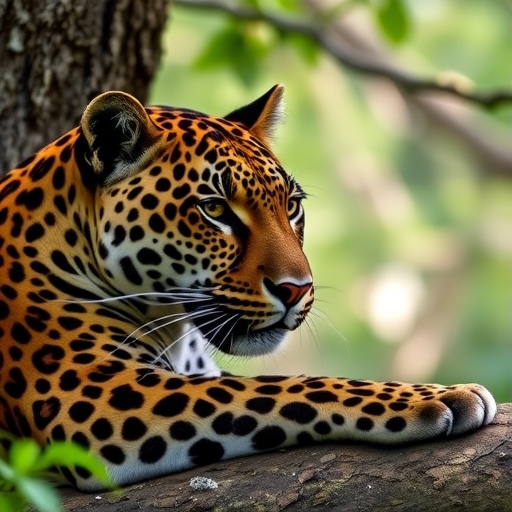In a groundbreaking study, researchers have delved deeply into the genetics behind melanism in the Indian leopard, scientifically named Panthera pardus fusca. This fascinating research, led by a team including prominent scientists like Ghosh, Kumar, and Porob, aims to shed light on the complexities of color variation in one of nature’s most elusive creatures. The results, presented in their article “Integrated genomic and structural dissection of melanism in Indian leopard,” provide a comprehensive look into how genetic factors influence the striking black coat of this magnificent animal.
The Indian leopard, known for its adaptability and stealthy hunting skills, typically exhibits a golden-brown coat adorned with rosettes. However, a subset of this species presents an intriguing phenomenon—melanism, which results in a nearly all-black appearance. This striking color variation has long intrigued biologists and conservationists alike, and the current research takes a significant step forward in understanding the genetic underpinnings of this trait.
The researchers employed a multidisciplinary approach that combined genomic analysis with structural dissection techniques. This comprehensive strategy allowed them to investigate not only the genetic sequences but also the structural proteins involved in melanin production. By analyzing the DNA of both melanistic and non-melanistic leopards, the team was able to identify specific genetic markers associated with the melanistic phenotype.
A pivotal aspect of the study was the use of advanced genomic techniques such as whole-genome sequencing. By sequencing the genomes of multiple leopards from different regions, the researchers were able to pinpoint variants that correlate with melanism. These genetic insights provide a clearer picture of how pigmentation varies even among closely related species, revealing that mild changes in specific genes can lead to profound visual differences.
The research examined known genes involved in pigmentation, such as the MC1R gene, which is well-documented in other species, including domestic cats and mice. However, the findings suggested that additional regulatory elements and possibly previously unidentified genes also play a vital role in the expression of melanism in Indian leopards. This layered complexity underscores the intricate interplay of genetics that governs not just color but possibly other adaptive traits.
The implications of this research are far-reaching. Understanding the genetic basis of melanism not only adds to the scientific community’s knowledge of leopard biology but also carries significant conservation value. Melanistic leopards are often subject to fascination and myth, which can influence conservation efforts. By unpacking the science behind their unique appearance, this study helps bridge the gap between public perception and scientific reality, fostering better-informed conservation strategies.
Furthermore, insights from this research could extend beyond the leopard to inform broader studies on color variation in other species. Animal pigmentation can be a critical factor in survival, affecting camouflage, mating, and thermoregulation. The genetic mechanisms identified in leopards may, therefore, have parallels in a variety of other animals, making this a pivotal moment in evolutionary biology.
This work also highlights the importance of genetic diversity within populations. As habitat loss and human activity continue to threaten wildlife, understanding genetic health is crucial for the conservation of species including the Indian leopard. The study emphasizes that melanism could be an adaptive response to environmental pressures, prompting researchers to consider how changing landscapes might influence the survival of these unique animals.
Moreover, the article encourages future research into the environmental and ecological factors that may trigger or inhibit melanism. Field studies integrated with genetic findings could uncover how climate, landscape, and prey availability incorporate into the genetic equation governing animal coloration.
As we advance into a new era of genomics and biotechnology, studies like this one represent the forefront of wildlife research. They pave the way for breakthroughs that could revolutionize our approach to conservation biology. By harnessing genetic insights, we can strive not only to protect these majestic creatures but also to maintain the ecological balance that depends on them.
In summary, the groundbreaking research by Ghosh, Kumar, Porob, and colleagues on the genetic basis of melanism in Indian leopards offers vital insights into the biological complexities of this phenomenon. As we unravel the tales woven within the genomes of these magnificent creatures, we further our understanding of evolution, adaptation, and the environmental pressures that shape the diversity of life on Earth.
This comprehensive exploration of melanism is not merely an academic exercise; it is a clarion call to prioritize conservation efforts based on scientific evidence. As we stand at the intersection of technological advancement and ecological responsibility, studies like these are crucial in informing policies and practices geared towards the protection of our planet’s biodiversity.
In conclusion, the intricate tapestry of genetics and environmental influences that dictate the survival and beauty of Indian leopards reminds us of the delicate balance of nature. It is our responsibility to ensure that future generations can witness the allure and majesty of not only the melanistic leopards but all forms of wildlife that share this planet with us.
Subject of Research: Genetics of melanism in Indian leopards
Article Title: Integrated genomic and structural dissection of melanism in Indian leopard (Panthera pardus fusca)
Article References:
Ghosh, A., Kumar, S., Porob, P. et al. Integrated genomic and structural dissection of melanism in Indian leopard (Panthera pardus fusca).
BMC Genomics 26, 1026 (2025). https://doi.org/10.1186/s12864-025-12227-z
Image Credits: AI Generated
DOI: https://doi.org/10.1186/s12864-025-12227-z
Keywords: Genetics, melanism, Indian leopard, conservation, evolutionary biology




